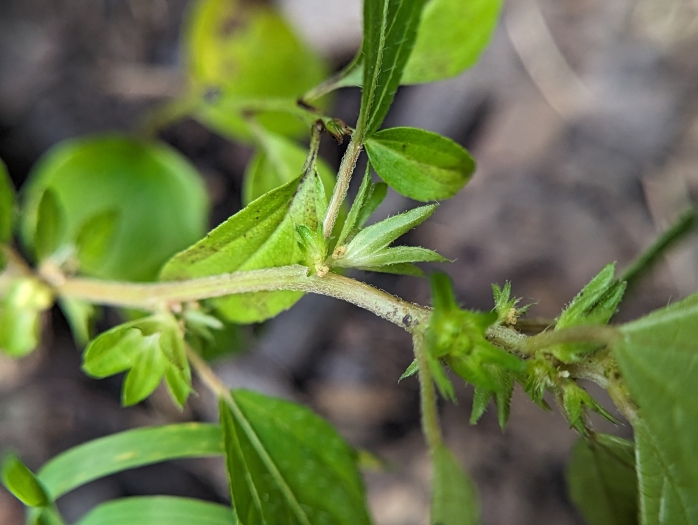Virginia Three-Seed Mercury
(Acalypha virginica)
Virginia Three-Seed Mercury (Acalypha virginica)
/
/

© Tom Sisan
CC BY-SA 4.0
Image By:
© Tom Sisan
Recorded By:
Copyright:
CC BY-SA 4.0
Copyright Notice:
Photo by: © Tom Sisan | License Type: CC BY-SA 4.0 | License URL: http://creativecommons.org/licenses/by-sa/4.0/ | Uploader: tom1548 | Publisher: iNaturalist |
























Estimated Native Range
Summary
Acalypha virginica, commonly known as Virginia Three-seed Mercury or Virginia Copperleaf, is a perennial herb native to the eastern United States, particularly thriving in disturbed sites such as fields, roadsides, and open woodlands. It is often found in areas with moist soil but can also tolerate drier conditions. This plant typically grows to a height of 1-3 feet (0.3-0.9 meters) and has a similar spread. The foliage is notable for its variable color, ranging from green to coppery tones, and the plant produces inconspicuous greenish flowers in the summer months.
Virginia Three-seed Mercury is valued for its ability to colonize and stabilize disturbed soils, making it useful for erosion control. It is also appreciated for its foliage color, which adds interest to naturalistic plantings and wildlife gardens. In cultivation, it requires minimal care, thriving in a range of light conditions from full sun to partial shade, and it is adaptable to various soil types, though it prefers moist, well-drained soils. While it is not commonly grown in formal garden settings, it can be used as a ground cover or in restoration projects. Gardeners should be aware that Acalypha virginica can self-seed prolifically, potentially becoming weedy. It is also potentially invasive outside of its native range, so caution should be exercised when planting it in non-native areas.CC BY-SA 4.0
Virginia Three-seed Mercury is valued for its ability to colonize and stabilize disturbed soils, making it useful for erosion control. It is also appreciated for its foliage color, which adds interest to naturalistic plantings and wildlife gardens. In cultivation, it requires minimal care, thriving in a range of light conditions from full sun to partial shade, and it is adaptable to various soil types, though it prefers moist, well-drained soils. While it is not commonly grown in formal garden settings, it can be used as a ground cover or in restoration projects. Gardeners should be aware that Acalypha virginica can self-seed prolifically, potentially becoming weedy. It is also potentially invasive outside of its native range, so caution should be exercised when planting it in non-native areas.CC BY-SA 4.0
Plant Description
- Plant Type: Herb
- Height: 1-3 feet
- Width: 1-2 feet
- Growth Rate: Moderate, Rapid
- Flower Color: Green, Red, Yellow
- Flowering Season: Spring, Summer, Fall
- Leaf Retention:
Growth Requirements
- Sun: Full Sun, Part Shade
- Water: Medium
- Drainage: Fast, Medium, Slow
Common Uses
Butterfly Garden, Erosion Control, Low Maintenance
Natural Habitat
Thrives in disturbed sites such as fields, roadsides, and open woodlands
Other Names
Common Names: Virginia Three-Seeded Mercury, Threeseeded Mercury, Virginia Copperleaf, Wax Balls
Scientific Names: , Acalypha virginica, Acalypha brevipes, Acalypha caroliniana, Acalypha crenulata, Acalypha digyneia, Acalypha echinata, Acalypha urticifolia, Acalypha virginea, Acalypha virginica f. intermedia
GBIF Accepted Name: